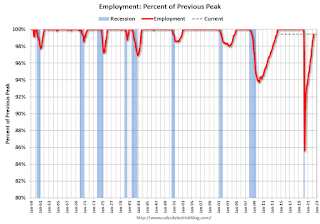The NBER's definition emphasizes that a recession involves a significant decline in economic activity that is spread across the economy and lasts more than a few months. In our interpretation of this definition, we treat the three criteria—depth, diffusion, and duration—as somewhat interchangeable. That is, while each criterion needs to be met individually to some degree, extreme conditions revealed by one criterion may partially offset weaker indications from another. For example, in the case of the February 2020 peak in economic activity, the committee concluded that the subsequent drop in activity had been so great and so widely diffused throughout the economy that, even if it proved to be quite brief, the downturn should be classified as a recession.The following graphs show the two key measures that NBER uses as a percent of the previous peak. (Real personal income less transfers and nonfarm payroll employment).
Because a recession must influence the economy broadly and not be confined to one sector, the committee emphasizes economy-wide measures of economic activity. The determination of the months of peaks and troughs is based on a range of monthly measures of aggregate real economic activity published by the federal statistical agencies. These include real personal income less transfers, nonfarm payroll employment, employment as measured by the household survey, real personal consumption expenditures, wholesale-retail sales adjusted for price changes, and industrial production. There is no fixed rule about what measures contribute information to the process or how they are weighted in our decisions. In recent decades, the two measures we have put the most weight on are real personal income less transfers and nonfarm payroll employment.
emphasis added
 Click on graph for larger image.
Click on graph for larger image.This graph is for employment through May 2022.
Employment is currently off about 0.5% from the pre-recession peak (dashed line). This is a significant improvement from off 14.4% in April 2020.
Employment is still 822 thousand below pre-pandemic levels.
 And the second graph is for real personal income excluding transfer payments through May 2022.
And the second graph is for real personal income excluding transfer payments through May 2022.Real personal income less transfer payments was at an all-time peak in May 2022.
These graphs are useful in trying to identify peaks and troughs in economic activity - and neither are suggesting a recession.
Note: See: Predicting the Next Recession. I'm not currently on recession watch.
No comments:
Post a Comment
Note: Only a member of this blog may post a comment.